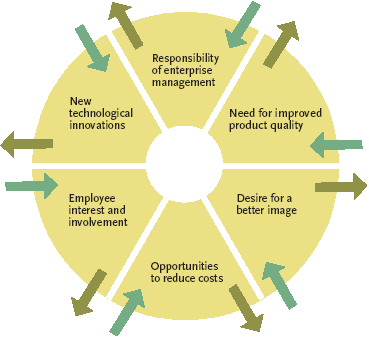An introduction to Life-Cycle Thinking and Management
2. Advantages with life-cycle-based environmental initiatives

It is important for an enterprise to predict new trends and possible threats. What one enterprise sees as a threat may be seen as an advantage by another. An enterprise's perspective on environmental change depends to a large degree on the enterprise's own environmental strategy as well as its internal readiness and commitment to undertaking integrated environmental initiatives.
There are a number of good reasons to begin with life-cycle-based environmental initiatives.
Internal driving forces
One of the internal driving forces is often an enterprise's desire to be at the forefront of new trends which may be profitable. Inspired by the United Nation's environmental organisation, UNEP, a list of driving forces includes the following (see also Figure 3).

Figure 3.
Internal driving forces and possible advantages
1. The responsibility of management
Management have a responsibility to minimise the environmental impact from products and processes. This responsibility includes the children in the daycare centre 200 metres down the road and extends to the hole in the ozone layer. Management are being urged to act with foresight, to take responsibility for their products, to phase-out environmentally detrimental substances, and to accept their scrap products back from customers, etc.
2. The need for improved product quality
Consideration of the environment in the product development and design stages may give a product new qualities in terms of functionality, durability, ease of maintenance and repair, etc. Thus, the quality of a product may be improved by considering environmental implications from cradle to grave.
3. The desire for a better image
A product and an enterprise's image may be improved by documenting the product's environmental profile in environmental communications, for example, in the enterprise's environmental policy or its green accounts. Thus, an enterprise can market itself, both to its own employees and to external partners, as an enterprise which makes on-going improvements to reduce the environmental impact of its products.
4. An opportunity to reduce costs
Often there are numerous opportunities to reduce costs which become evident during a product-orientated initiative, for example, reduced material costs, less waste, optimised logistics, lower resource consumption, and fewer emissions from each production step.
5. Employee interest and involvement
Employees as well as management must take responsibility for the environment. Employees have an interest in removing harmful substances from production as it will improve their work-place environment. When employees contribute with suggestions regarding environmental improvements, their pride in the product's workmanship increases. A good enterprise and product reputation has a positive effect on employee recruitment.
6. New technological innovations
Technological innovations in the form of new materials or inventions can radically improve a product's environmental profile by increasing its energy efficiency, durability, etc. An explicit environmental profile may lead to breakthroughs into new markets.
External driving forces
Most enterprises are involved in close collaboration with a number of partners. These relationships may provide opportunities for life-cycle-based environmental initiatives, or demands may be imposed, for example by authorities. Collaboration may also give the opportunity to achieve several advantages (see also Figure 4).
1. Goodwill with the authorities
A front runner environmental initiative creates goodwill with the authorities, as the authorities adjust inspection and supervision of an enterprise according to the enterprise's own level of initiative. At the same time it is expected that enterprises take responsibility for the environmental impacts from their own processes and products.
2. Advantages in market competition
Development of cleaner products and eco-labelling according to the EU Flower and the Nordic Swan criteria may give a strategic advantage on the market in terms of a greater market share and increased sales. A life-cycle-based environmental initiative may give the product an extra quality which may be a contributing factor in a customer's selection of the product rather than a competing product.

Figure 4.
External driving forces and possible advantages
3. Public demands
Contact with friends, neighbours, the media, etc. creates situations where both management and employees are questioned regarding the enterprise's environmental performance. An environmental communication regarding the enterprise's environmental initiatives provides "the right answers" and a good public image.
4. A frontrunner compared to the competitors
An enterprise which has the internal readiness for, and commitment to, lifecycle based environmental initiatives has the opportunity to be a frontrunner in the development of cleaner products, rather than just following the competitors. As a trend-setter, an enterprise becomes an attractive and credible supplier.
5. Network collaboration and demands from business associations
Many sectors collaborate via networks or product panels on productorientated environmental initiatives. A few business associations require member enterprises to introduce a certified environmental management system. Other sectors have developed their own guidelines for "good environmental behaviour".
6. Collaboration among suppliers regarding environmental innovations
Increased collaboration between suppliers may provide advantages in terms of exchange of knowledge and experience, improved supply assurance, flexibility as well as mutual assistance with development of new products and services. Closer cooperation with mutual advantages may lead to partnerships which create new environmental innovations.
Grab the chance
Enterprises are all different. This is also true of the driving forces which influence an individual enterprise. Often enterprises are pictured as maladjusted, surrounded by numerous thick, pointing arrows representing new demands from the market place, the state, etc.
But enterprises are also responsible for their own state of affairs. By focusing on the internal driving forces an enterprise develops knowledge, an environmental commitment, and readiness so it can quickly pick up on new trends and take initiatives when customers, neighbours, authorities or other partners voice new desires or demands.
An enterprise which is well prepared for a life-cycle-based environmental initiative is able to strategically develop and market cleaner products. A proactive environmental strategy means that the enterprise is the leader and can thus play a determining role in the interplay between partners. It is important for an enterprise to discuss the various driving forces when trying to set the ambition level and goal(s) with regard to development and marketing of cleaner products.This subject is discussed in the next chapter.